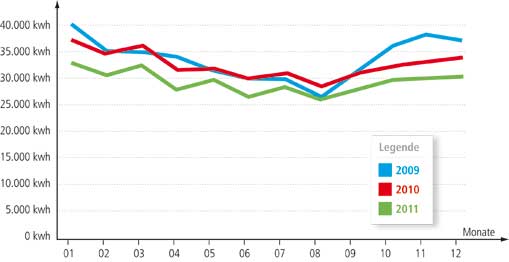
District administration: Lighting and air-conditioning control
Presence detectors and CO2 sensors in the Zollernalbkreis district administration building provides a "great climate" – and not just because the monthly peak load sank from 150 KW to 102 KW.
Quality from the country
Why go miles and miles? Bernd Rentschler was always keen to use control devices from Theben AG. They are ideal for the requirements in public buildings in the Zollernalb district. Another element of his principles is to take a look at the manufacturers in the region and use their products where they fit the bill in terms of function and quality. In his big project for the Balingen district administration complex, he opted for the installation of over 200 ThebenHTS presence detectors in his role as head electrician. They provide the required control of lighting, heating and ventilation. The rural district at the foot of the Hohenzollern castle benefits from the efficient use of energy and its employees and visitors from optimum lighting and ventilation. Even in the large meeting room, an AMUN 716 R CO2-Sensor from Haigerloch provides an “excellent climate“ for the local politicians.
Multi use of functions
The offices, meeting rooms, corridors etc all enjoy comfortable and efficient lighting. Automatic controls and systems control technology have also been achieved. Bernd Rentschler had already used ThebenHTS presence detectors in schools. That’s why presence detectors like the ECO-IR 360-24V now control the lighting in the district administration buildings. At the same time, features like accurate daylight measurement, adjustable brightness values and self-learning switchoff delay are a positive benefit. It is switched on manually. The lighting switches itself off if there is enough daylight or if the room is empty. The presence signal from the HVAC contact, which switches independently of the brightness level, moves the heating from standby to comfort mode or back. The appropriate blinds go up if nobody in the room needs shade in order to maximise use of the available solar heat on cold days. Another, clever energy-saving idea is the automatic switching off of monitors at work stations via presence contacts. A small controller (SPS) is used to link the functions. This is connected to the building systems technology via an IP interface and data network. “We now have central control of room functions using conventional devices,“ said Bernd Rentschler pleased with the simple but effective networking.
Drop in ventilation loss
The compact passage 24 V presence detector automatically provides good illumination for the requisite lighting of corridors and staircases. The rectangular detection area of the presence detector with its special detection quality is ideal for use in long corridors. Bernd Rentschler considers air conditioning control in meeting rooms using the AMUN 716 R CO2 sensor to be a “wonderful solution“. Before that, the ventilation was always running during meetings. Heat recovery does retrieve 80 per cent the ventilation losses. The ventilation loss is now further reduced as the ventilation switches on and off as required. “I’m extremely satisfied“, he said in his summary of automation using the CO2 sensor and the ThebenHTS presence detectors. The whole refit helped to reduce the peak load from 150 KW to 102 KW/month.
|
|
| The presence-dependent lighting and ventilation control reduced the peak load from 150 KW to 12 KW/month. |
Reference (pdf)
"Lighting and air-conditioning control in public buildings"
Image source: Elmo Schwandke, Geretsried

